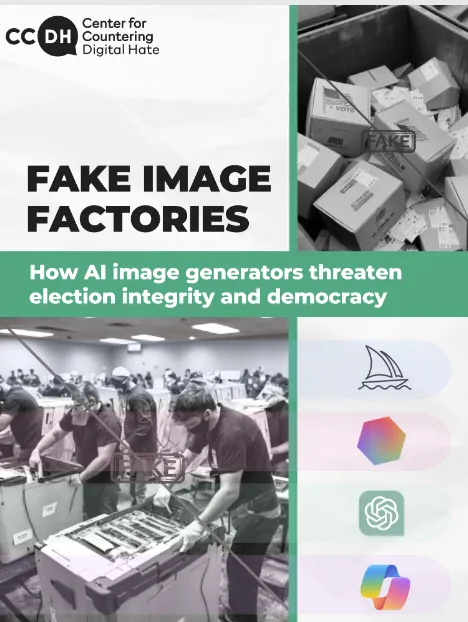What you need to know about online misinformation and disinformation and the 2024 elections

In the context of elections, social media and other digital platforms can have an important role in enabling candidates to reach a wider audience and engage voters. However, recent elections around the world have shown that these platforms also allow the spread of hate speech, false or misleading information, conspiracies, and propaganda.
In 2024, over four billion people will go to the polls. It is increasingly important for social media platforms to act against the amplification of election disinformation. Yet, we have seen the opposite: companies cutting their content moderation efforts and allowing AI deepfakes to flood our timelines.
The consequences are not constrained to the digital world. The amplification of disinformation during elections can affect personal relationships and incite both online and offline hate. Ultimately, disinformation undermines public trust in the integrity of the electoral process and harms democracy.
Navigating an increasingly polarized social media during elections can feel overwhelming. In this article, we show how the spread of hate and disinformation enabled by these platforms can impact the 2024 elections, why it’s important to be cautious, and what you can do to avoid amplifying false information.
Social media and elections
Social media platforms have become important tools in elections. Candidates use their accounts to promote their campaign platforms and events, to share important announcements, and to engage voters in the run-up to polling day. Yet, these platforms have also become a tool to spread disinformation, misinformation, and abuse during elections.
The United Nations Educational, Scientific and Cultural Organization’s (UNESCO) guide to “Elections in Digital Times” compiled a list of ways social media has been used to harm elections. Among other actions, it includes:
- The misrepresentation of voter information that can lead to voter suppression;
- The spread of disinformation with the intent to cause harm to persons, groups, institutions, or processes
- Coordinated inauthentic behavior (CIB): when there is a coordinated effort to spread false or misleading information using fake accounts. Disinformation spreaders, for example, use troll farms or troll factories “to get content trending, generate online debate, influence public opinion and decision-making.” These services are usually paid for.
- The spread of hate speech and incitement to violence “in ways that undermine public trust in democratic institutions and increase the risk of electoral violence and political instability”
- Digital attacks against women, journalists, and other political, institutional, and media actors
How does the spread of online disinformation and misinformation affect elections?
The spread of both disinformation and misinformation on social media can undermine the electoral process and weaken democratic institutions.
Disinformation is false or inaccurate information that is spread intentionally. During elections, bad actors often weaponize social media channels to spread disinformation in coordinated ways, often in order to undermine opponents’ chances or institutions’ credibility.
Social media companies profit from the spread of election disinformation and controversy, so they often boost this content on their platforms, reaching millions of people. This comes at the cost of election integrity.
The controversial, inaccurate, or false content amplified by social media plays with our emotions and our biases. It is common to see it being shared by people who don’t necessarily have the intention to deceive – sometimes they truly believe in it or engage with it because it makes them angry.
Social media’s algorithms not only amplify harmful content but also divide people into partisan bubbles, showing a partial picture of how others feel about candidates and political issues. Both traits can affect elections by increasing polarization, distorting reality, and lowering tolerance for different political views.

Clear examples of how the spread of disinformation online can cause real-world consequences are the January 6th US Capitol attack and the 2023 Brazilian Congress invasion. Both attacks were planned on social media and incited, in great part, by the spread of disinformation about election fraud.
How can AI impact elections?
The rapid development of more sophisticated Artificial Intelligence (AI) models, such as OpenAI’s Sora, can turn AI into a powerful and dangerous tool for disinformation and misinformation spreaders in upcoming elections. AI platforms have a duty to combat election disinformation.
Fabricated images, videos, and audio clips of false events, known as deepfakes, are becoming more and more convincing. They often depict celebrities or politicians in situations that have never happened, making it harder for people to discern which events are real and which are not.
Deepfakes are already being used in the context of elections. A few days before the 2023 election in Slovakia, audio recordings in which one of the candidates appeared to be saying that he’d rigged the election went viral on social media. The audio was false and created with AI. It was not possible to measure the impact of the audio on voters, but the candidate whose voice was manipulated was defeated in the polls.
In the UK, a deepfake audio of the Labour opposition leader Sir Keir Starmer emerged on the first day of the party’s annual political conference in 2023, threatening to derail the event in controversy. London Mayor Sadiq Khan has also fallen victim to deepfakes around false audio of him playing down the importance of Remembrance Day commemorations, which spread widely amongst far-right groups.
In 2023, false images of former US President Donald Trump being arrested circulated on social media amid reports that Trump could be indicted by a grand jury in New York. These false images were fabricated using the AI image generator Midjourney.

CCDH’s research has shown that popular AI tools can be used to fabricate election disinformation, which could seriously harm democracy. In March 2024, we tested the AI image generators Midjourney, ChatGPT Plus, DreamStudio, and Microsoft’s Image Creator using text prompts about the 2024 US presidential election. Out of 160 tests, these platforms generated election disinformation in 41% of cases, including images that support false claims about candidates and election fraud.
In May, we tested six popular AI voice cloning tools and found that they generated convincing election disinformation in the voices of leading US, UK, and EU politicians in 80% of our tests. These included audio deepfakes mimicking Joe Biden, Donald Trump, Keir Starmer, Rishi Sunak, Emmanuel Macron, and Ursula von der Leyen.
Who are the main targets of disinformation during elections?
According to Unesco’s “Elections in Digital Times” guide, the spread of disinformation during election cycles can target a broad range of actors and institutions:
- Electoral Management Bodies
- Candidates and political parties
- Political activists, members of non-profits, and civil society organizations
- Minorities and members of other vulnerable groups
- Journalists, media outlets, and human rights defenders
- Citizens/voters
Research has shown that women in politics are disproportionately targeted by disinformation attacks and abuse, a pattern that tends to be stronger when considering women from minority groups. In addition, deepfake videos with sexual content are often used to shame and deter women candidates, sometimes driving them away from politics altogether.
An extreme case was the murder of the UK Labour MP Jo Cox, in 2016, by far-right white supremacist Thomas Mair. Mair’s slow-cooked hatred against immigrants and white liberals, who he considered “traitors to his race”, was fired up by the wave of online and offline hate and misinformation amid the Brexit campaign.
What can social media and AI platforms do to tackle election disinformation and hate?
- Social media and AI platforms must enforce their own policies against misinformation and hate speech, and invest in trust and safety staff dedicated to safeguarding against the use of generative AI to produce disinformation and attacks on election integrity.
- Social media platforms must provide responsible safeguards to prevent users from generating, posting, or sharing images that are deceptive, false, or misleading about geopolitical events and impact elections, candidates for public office, and public figures.
- AI tools must provide responsible safeguards to prevent users from generating images, audio, or video that are deceptive, false, or misleading about geopolitical events, candidates for office, elections, or public figures.
- Voluntary commitments to counter AI misinformation during elections are welcome, but lawmakers must still establish minimum standards for social media and AI platforms to hold these companies accountable.
Social media companies should be responsible for the amplification of hate and disinformation during elections. However, people can do their part to keep social media less toxic during elections. Here’s some practical advice on how to avoid sharing disinformation:

6 tips to help you navigate social media during elections
We’ve compiled CCDH’s best tips and those from other expert sources such as PolitiFact, New Literacy Project, and MIT Media Lab.
1) Verify information before sharing
Always verify the source and authenticity of the information you’re sharing to the best of your ability. Cross-reference facts with reliable news outlets to confirm the accuracy of the content. Social media is not a reliable way to confirm accuracy, since it is far more prone to containing disinformation than major news outlets which are subject to professional codes of conduct, and can be held liable under the law for harm.
If you’re in doubt about your voting requirements or general voting information, look for primary sources, such as your country’s official electoral body’s website. For information about candidates’ platforms, go to their official websites to learn what they’re advocating for and against.
As a rule of thumb: if you can’t verify that information is correct and legitimate, then don’t share it.
2) Be skeptical of non-expert accounts:
Be cautious of sharing content from unverified or anonymous social media accounts. Avoid falling into a trap: just because a post was liked or shared many times doesn’t mean that its content is accurate.
Your country’s official electoral institutions, reputable journalists, and established news organizations are more reliable sources of information.
3) Be on the lookout for voter suppression tactics and claims of fraud
PolitiFact highlights two trends that have emerged on social media in the run-up to polling day in recent elections.
First, it is important to be skeptical about voting information that doesn’t come from reliable sources. For example, disinformation in “posts that say immigration officials are arresting voters at the polls; that you can vote via text message; or that voting machines are malfunctioning” were seen in the 2016 and 2018 elections in the US.
Baseless claims of election fraud have also taken social media by storm in recent years. Before sharing content that advances these claims, it’s important to verify if there is any evidence supporting them. Disinformation about election fraud is often weaponized to undermine election integrity and democracy.
4) Be skeptical of images, audios, and videos you find online
Poor-quality deepfakes are easy to identify, but it gets harder as technology develops. Some elements that can give a deepfake away are:
- Pay attention to the skin tone and how smooth/wrinkly the skin is.
- Take a careful look at the eyes and notice if there are any weird shadows or incongruent glares on the glasses. Lack of blinking can also give a deepfake away.
- Pay attention to the lips – are they moving in a natural way?
Be skeptical of images, videos, and audios in which candidates behave differently from the ordinary, or say something that is completely out of character (including admitting to committing crimes).
If the content is real, check the context they were taken from – sentences can change meaning when taken out of context. You can check trusted sources such as BBC Verify, Reuters, AFP, AP, and PolitiFact. You can also use tools like Google Reverse Image Search to find out more about an image’s context. If it is a video, you can take a screenshot and then use the reverse search function.
Check the information but make sure you don’t amplify false or misleading content when trying to debunk it.
5) Report false information
If you encounter content that appears to be false or misleading on social media, report it to the platform. We know platforms can be bad at enforcing their own rules. But if you come across false, misleading, or violent content that you think shouldn’t be online, reporting it is a positive first step.
6) Share verified information and reliable sources with your friends and family
It is not always easy to discern which piece of information is true and which is false when navigating social media during elections. If you spot your friends and family sharing content you know is false or inaccurate on social media or any messaging app like WhatsApp or Messenger, reach out to them with accurate information. Research shows that some people trust information coming from or endorsed by friends and family members more than from other sources.
You can also share this explainer with your friends and family and help build a more informed and resilient democracy.
Join our email community to receive updates on our latest research, campaigns, and explainers.